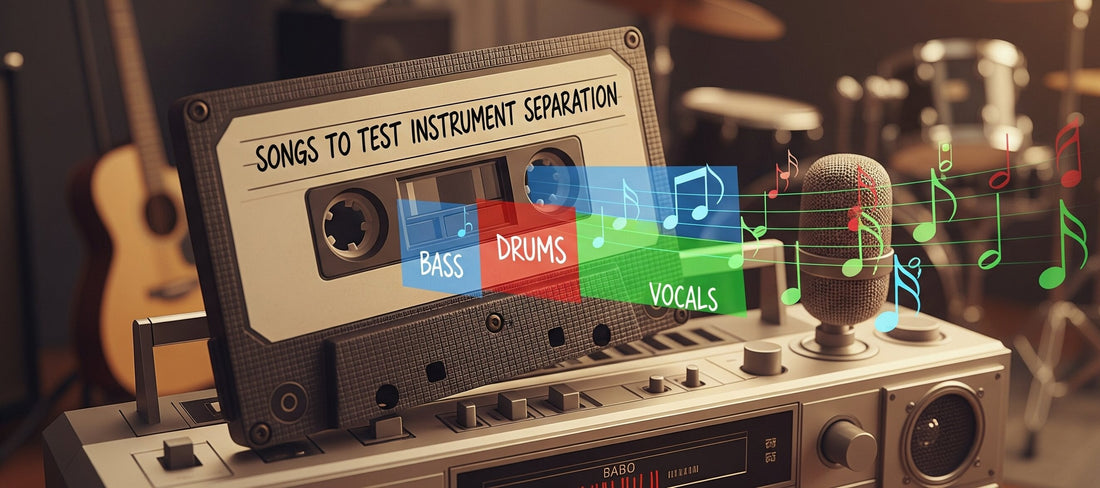
Five Songs to Test Instrument Separation: Bringing Out Each Layer of Sound
Share
For audiophiles, instrument separation is a vital part of the listening experience. When each instrument has its own space, the music becomes more lifelike, allowing listeners to hear every layer distinctly. High-quality audio gear emphasizes these subtle distinctions, making it feel as though the listener is sitting right in front of each musician. In this article, we’ll look at some classic songs that showcase instrument separation.
Top 5 Songs for Testing Instrument Separation
These songs are celebrated for their detailed layering, giving each instrument room to breathe.
1. "A Day in the Life" by The Beatles
- Why It’s Great for Testing: This track’s complex production and layering of instruments, sound effects, and vocals provide an excellent test of instrument separation. With good audio gear, each section becomes distinct, from the subtle piano lines to the orchestra crescendo.
2. "Little Wing" by Jimi Hendrix
- Why It’s Great for Testing: Known for its intricate guitar work and soulful background instruments, “Little Wing” highlights the need for separation between high and low frequencies. Each layer, from Hendrix’s guitar to the bass, should feel separate yet harmonious.
3. "Roundabout" by Yes
- Why It’s Great for Testing: This progressive rock classic combines powerful basslines, layered guitars, and complex drum patterns. Good equipment reveals the nuances of each layer without letting them blend, especially during the song’s faster sections.
4. "Take Five" by The Dave Brubeck Quartet
- Why It’s Great for Testing: The iconic saxophone melody, rhythmic piano, and drums in “Take Five” require a balanced setup to capture each instrument’s space and tone. Great audio equipment will allow listeners to focus on each instrument’s contribution to the whole.
5. “Aja” by Steely Dan
- Why It’s Great for Testing: The title track from Aja is studio craftsmanship at its most meticulous—an ideal clinic for instrument separation. Listen to how the rhythm section (electric bass, kick, and tightly tuned snare) locks the center while Rhodes and acoustic piano occupy distinct lateral planes. Tenor sax sits forward with breath and reed texture, background vocals are feathered behind the lead image, and auxiliary percussion (shaker, ride, tambourine) floats in the upper corners without masking the core groove. During the extended drum improvisation near the finale, a resolving system keeps tom runs, cymbal splashes, and ghost notes discrete, preserving the shape of each transient and the space around it. Lesser rigs collapse these layers into a glossy sheet; good systems let you “walk” through the mix, instrument by instrument.
Tips for Enhancing Instrument Separation
- Geometry of the Speaker: Build a stable equilateral triangle and micro-adjust toe-in in 1–2° steps until the center image “locks.” Slight rake (tweeter aimed at ear height) often clarifies lateral placement and depth cues.
- Control First Reflections: Treat sidewalls and the floor/ceiling early-reflection points with broadband absorption; add diffusion behind the listening position. Reduced early reflections sharpen edges between instruments without drying the room.
- Integrate Low Frequencies: Align subwoofer crossover, phase, and delay so bass transients stop when they should. Excess LF overhang masks microdetail and causes midrange images to wander.
True instrument separation isn’t about pulling the music apart—it’s about letting distinct lines coexist without contention. The best systems render lateral position, depth, and ambience so convincingly that you can follow any part at will without losing the whole. On a well-sorted rig, the sound unfolds as a layered, three-dimensional tableau: rhythm section anchored, keys in their own air, sax tangible, and cymbals etched yet effortless. If your setup maintains that hierarchy as mixes grow dense, you’ve achieved separation that serves the music rather than dissecting it.
